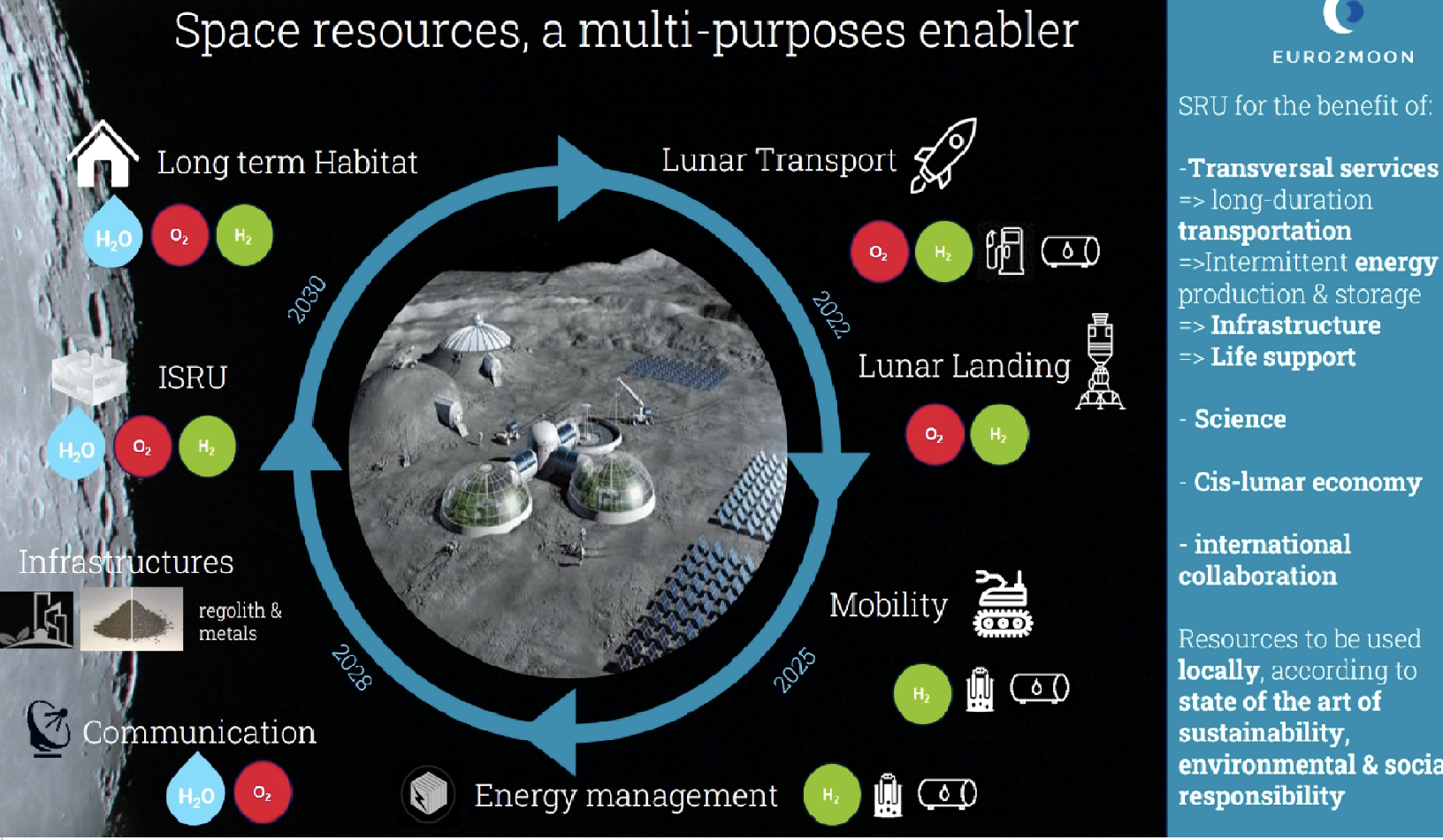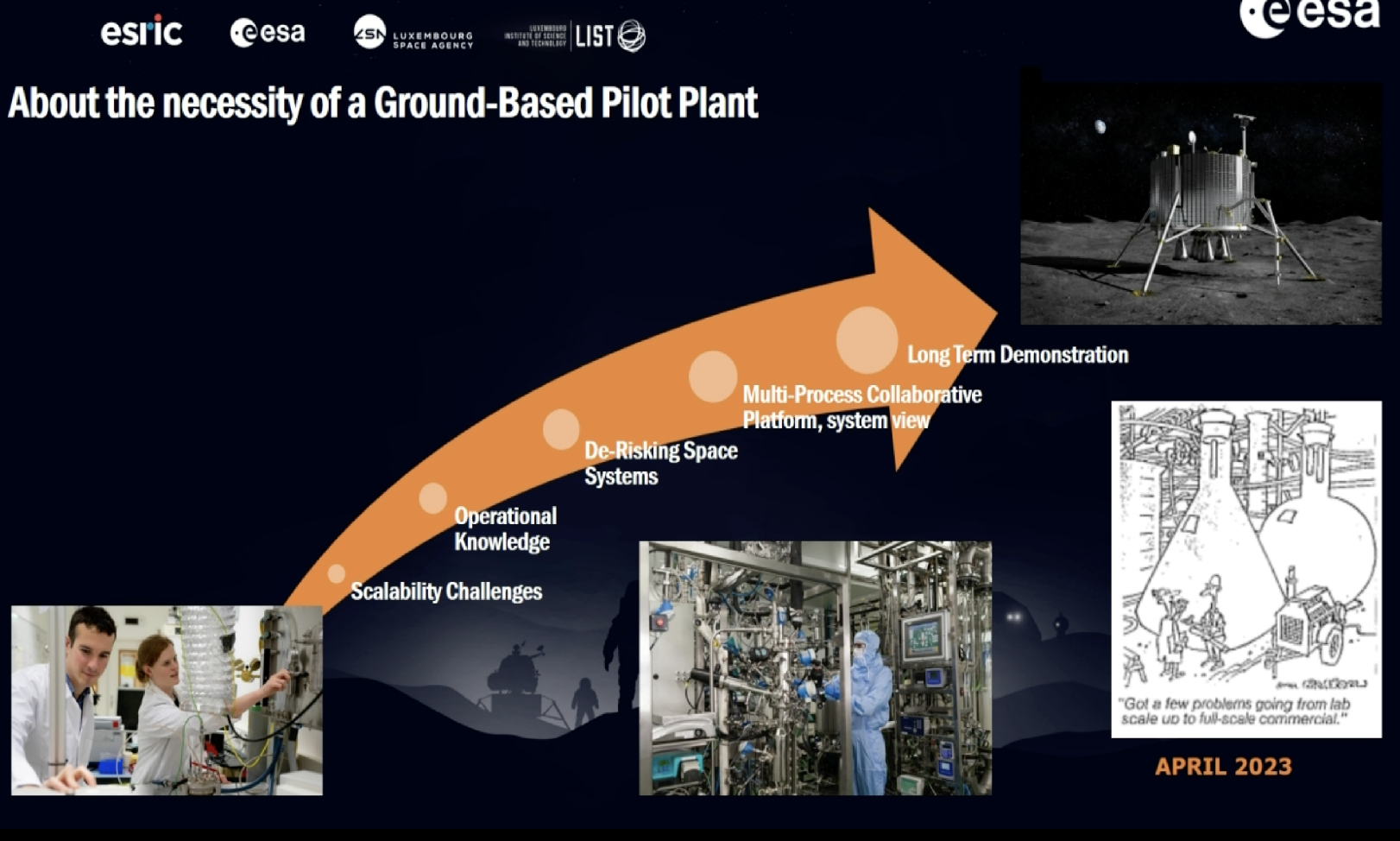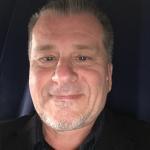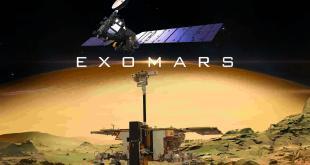By Christophe Bosquillon

The 2023 edition of Space Resources Week (SRW) took place on 19-21 April at Luxexpo The Box and online. This event is organised by the European Space Resources Innovation Centre (ESRIC), in collaboration with the European Space Agency (ESA), Luxembourg Institute of Science and Technology (LIST) and the Luxembourg Space Agency (LSA). More than 100 presenters from key institutions took to the stage or showcased their teams work through their posters. In 2023, more than 1,250 people attended the event: 450 on-site and 800 online: that compares with 200 at the 2019 beginnings and 1,000 at the 2022 edition, on which SWGL reported here and here. Watch out for the SRW 2023 video content to be shortly released on the ESRIC YouTube account.
Franz Fayot, Luxembourg Minister of Economy, in his opening address reminded the audience that 2023 is the 5th anniversary of the Luxembourg Space Agency. Not only is SRW gaining traction as an event, but the Minister was keen to announce initiatives under way that provide further momentum, such as the call for ideas for the ESA & ESRIC Space Resources Challenge, the Terrestrial Pilot Plant Consultation, and the ESRIC Start-up Support Programme. This year, the ESA-ESRIC challenge presented small robotic solutions for Moon mobility when crawling across regolith dust and dealing with challenging slopes.
European countries must have the means of their space politics and the space politics of their means, as the Union tries to exist in a third position behind the US and China.
While NASA administrator Bill Nelson heralded the return to the Moon, Josef Aschbacher, Director General of ESA emphasised SRW 2023 focus on commercialisation, to which Bernhard Hufenbach, Lead of the Commercialization and Innovation Team at ESA Human and Robotic Exploration Directorate (HRE) added the need to demonstrate use cases in space. ESRIC Director Kathryn Hadler reminded the audience that the ESRIC team, made of 16 people representing 14 nationalities, will keep expanding its programmes. Other opening statements set the tone for what would turn out to be an event focused on R&D and hardware capacity building: Gerald Sanders, NASA, covered mining gap analysis. Kyeong Ja Kim from the Korea Institute of Geoscience and Mineral Resources (KIGAM) demonstrated how interstellar gamma ray expertise can be applied to radiations assessment. ESA astronaut Matthias Maurer reminded everyone that an increase of radiation-linked cancer risk by 3% is a career-killer for an astronaut aiming at the Moon and Mars.
A pragmatic agenda demonstrating scientific capacity-building in Europe
SRW 2023 took place the same week as the Colorado Springs Space Symposium, in between first-time attempts by SpaceX Starship and iSpace Hakuto-R at sub-orbital flight and landing on the Moon respectively.
The weighting of countries in the agenda highlighted the indispensable relationship between Europe and North America in the space domain. International cooperation was also emphasized with the role of other countries invested in Luxembourg, such as Japan with iSpace but also the achievements of JAXA in asteroid sample return missions. Origin Space represented China’s current involvement in space mining. European countries must have the means of their space politics and the space politics of their means, as the Union tries to exist in a third position behind the US and China.
A significant portion of the agenda dealt with R&D relative to lunar and Martian regolith simulants, analyses, and utilization. This Part 1 scans through mission planning, technology showcases, and hardware capacity building, focusing on topics relevant to the extraction and use of space resources, such as mining, the intersection of ISRU with digitalization, and terrestrial and lunar infrastructures.
Mining
Opening statements by Gerald Sanders, NASA, covered remaining challenges of space resources utilisation (SRU) through a neat mining gap analysis for SRU from the Moon to Mars. As previously reported in Part 2 of the coverage of SRW 2022, understanding mining gaps matter to make sure terrestrial mining operational frameworks are understood prior to tackling the space domain.
Terrestrial mining majors manage a value chain of contractors for actual operations. Majors get involved in infrastructure investment only once potential “resources” are quantified as economically exploitable “reserves”, and once all Technology Readiness Levels (TRLs) issues are resolved. On Earth, initial steps will be executed by ventures rather than majors. A similar modus operandi is likely to apply on planetary bodies, starting with the Moon where a flurry of challenging TRLs is required to effectively deal with harsh lunar environment constraints, across all the phases of the mining life cycle.
It turns out that automation, digitalization, and a data economy are steadily making their way across SRU activities.
Douglas Morrison, from the Centre for Excellence in Mining Innovation (Canada) emphasized the issue of energy consumption of mining vehicles: rovers are good for moving around but not for transporting mined material. Small energy effective transportation systems are needed for that usage on the Moon, and would also require rest power stations for machines for extreme cold and heat. Clive Neal of the Lunar Surface Innovation Consortium (LSIC) presented how the consortium uses geology and planetary science to offer a framework focused on six areas relevant to mining: dust mitigation, excavation and construction, extreme access, extreme environments, surface power, and ISRU (in situ resources utilization).
An indication that participants in the terrestrial mining value chain may be paying some attention to the Moon was the intervention of Epiroc, a mature Swedish company with 70,000 employees, active in the drilling and excavation segment of the mining value chain. Its representative Miriam Bergvall highlighted the need for specific lunar data to define engineering requirements for mining hardware. Carlos Espejel of iSpace was again present at SRW 2023, as he led the PhD team that developed the « Lunar Ore Reserves Standards 101 (LORS-101) » mining framework: LORS-101 reconciles lunar mining with techno-economic models and mining investments lifetime risk profiles used in terrestrial mining and oil & gas extraction. This is about inter-disciplinary and cross-industry cooperation between space domain professionals and professional of relevant industries such as mining, energy, etc., and understanding prerequisites such as data and issues to be resolved for a way forward.
The intersection of ISRU and digitalization
It turns out that automation, digitalization, and a data economy are steadily making their way across SRU activities, as demonstrated by several tangible achievements. AI can be used to predict the nature and location of volatiles on the Moon, a prerequisite to relevant resources extraction and utilization: as solar winds remove hydroxides from lunar regolith (OH, H2), it is assumed that particles either escape upward to the lunar exosphere, or fall back to the surface, where they become trapped further away within the regolith (a behaviour summed up as “ballistic”). WGM from Canada developed an AI-predictive modelling system that allows mapping of lunar water cycles and volatiles dispersion patterns: the ballistic behaviour of each type of particle leads to these falling back into specific areas that can be clearly differentiated, allowing identification of a specific volatile based on the location it fell back in. That allowed WGM to develop a deep learning-based predictive model to identify, for each particle and their isotopes, to which volatile category they belong to, based on their dispersion pattern.
A presentation by Veneranda Lopez Dias of LIST on the sublimation and water losses to the exosphere under specific conditions of pressure and temperature reinforced some of the WGM finding: LIST demonstrated how crucial it is to look at isotopes to differentiate water for human consumption from water for other uses. The science behind ISRU and the survivability of human presence on the Moon and beyond is complex. It is also worthy of further assessments, such as its applications proving beneficial for terrestrial ecosystems and societies.
Terrestrial and lunar infrastructures
A key takeaway from SRW 2023 is the building of a terrestrial pilot plant. Melchiorre Conti mentioned the parallel concept of a pilot plant on the Moon, while Brigitte Lamaze discussed the scalability challenges linked to a ground-based pilot plant. Ian Mellor of Metalysis, Pascal Barbier of AirLiquide, and all, agreed a collaborative effort is mandatory to build relevant Moon ISRU open architectures.

Jonathan Slavik of Astrobotic tackled putting landing pads in place before there are landing pads in place: Astrobotic showcased its low energy additive construction polymer binder regolith, with closed-loop water recollection, that holds rocket fire, and facilitates refurbishing of pads after landing and take-off. Arthur Woods of Astrostrom covered Space-Based Solar Power and Moon manufacturing (Astrostrom is also known for their “Here To Stay” concept using a Starship rocket as lunar habitat.)
Conclusion
The SRW 2023 agenda demonstrated focused scientific capacity building in Europe with partnerships from North America to Japan, and covered topics relevant to extraction and use of space resources, such as mining, the intersection of ISRU with digitalization, and terrestrial and lunar infrastructures. In Part 2, we will review the commercialization and regulatory sessions, together with aspects relevant to the prospects of Europe in the space resources utilization emerging market.

Christophe Bosquillon has a diverse professional background, having operated globally with a focus on the Indo-Pacific region. His experiences in Japan, the Koreas, Taiwan, China, ASEAN, India, Russia, and Australia have given him a deep understanding of the multipolar realpolitik of our world under the Pax Americana. With a background in engineering, trade, and foreign direct investment in industries relevant to Space Resource Utilization (SRU), such as mining, transportation, energy, manufacturing, agrifood, environment, and digitalization, Chris is committed to developing SRU value chains that benefit the Earth. As an executive, owner, writer, and founder of Autonomous Space Futures Ltd, Chris has extensive experience in collaborative policy crafting and works to develop space business and governance models relevant to society. He is a member of NGOs that provide input to the United Nations Committee on the Peaceful Uses of Outer Space (UNCOPUOS) legal subcommittee Working Group on Space Resources. Chris contributes to regulatory clarity on appropriation, priority, sustainability, and sharing in a way that balances national interests with civil society inclusion, provided a transparent due process is followed. When advocating for access to technology and space for the Global South, Chris believes that emerging space powers’ participation in space markets must be commensurate with their interest and involvement in international space politics. He believes that their ability to develop sovereign domestic capabilities with spillover potential is also essential. Chris is keen on ‘Peace Through Strength’ diplomacy and deterrence-based security as enablers of secure space access. He supports sovereign cislunar space situational awareness as mandatory for freedom of circulation in the space domain and deconflicted cooperation on the Moon.





